Christian Couch, M.S.
 Graduated Summer 2024
Graduated Summer 2024
Email: christian.couch@ufl.edu
I am an M.S. biotechnology student in the college of Agricultural and Life Sciences. I work on many molecular projects relating to conservation, biodiversity and phylogenetics within Lepidoptera. I am also interested in studying Chemistry and Ecology and Conservation outside of research. I enjoy the wildlife, collecting insects and traveling.
Chelsea Skojec, Ph.D.
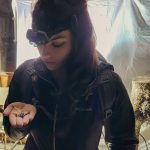 Graduated Summer 2024
Graduated Summer 2024
Email: chelseaskoj@ufl.edu
I am interested in the evolution of complex traits used in anti-predatory defenses. Specifically, my research focuses on the evolution and efficacy of conspicuous coloration and patterns such as eyespots, used in deimatic displays. I am using an integrated approach of phylogenetics, genomics, and AI to provide a better understanding of these traits and their evolution.
Jacob Bethin, M.S.
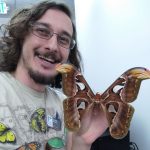 Graduated Spring 2024
Graduated Spring 2024
Email: bethinj@ufl.edu
I am an M.S. entomology student interested in the taxonomy and systematics of aquatic moths (Crambidae: Acentropinae). My research pertains to creating the first molecular phylogeny of Acentropinae to help further understand their biology and evolutionary history. I am also a recipient of the McGuire Graduate Research Assistantship, and am responsible for assisting with the curation of Pyraloidea and other Lepidoptera in the MGCL collections.
Amanda Markee, M.S.
 Graduated Spring 2023
Graduated Spring 2023
Twitter: @kkbugtime
Email: amarkee@floridamuseum.ufl.edu
I’m a full-time bug enthusiast interested in conservation genetics, population ecology, and evolution. I’m currently managing lab personnel for the Kawahara Lab and helping with molecular projects pertaining to phylogenetics, community ecology, and biogeography. Outside of my research, I am interested in science outreach in the context of museums, diversity in STEM and open access to science.
Juliette Rubin, Ph.D.
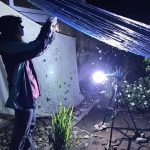 Graduated Spring 2023
Graduated Spring 2023
Email: julietterubin@ufl.edu
ResearchGate
I study the evolution of elaborated traits, focusing on Lepidoptera. I am interested in understanding the evolutionary route and process by which traits emerge and how they are maintained by multi-predator communities and sexual selection. In Dr. Kawahara’s lab I am using behavioral and phylogenetic approaches to further explore specialized wing traits in Saturniidae, especially focusing on the Actias clade.
Nick Homziak, Ph.D.
 Graduated Spring 2022
Graduated Spring 2022
Email: nhomziak@ufl.edu
Website
My research focuses on the taxonomy and systematics of moths in the family Erebinae. This subfamily is distributed globally and is most diverse in the tropics. Outside of the holarctic , these moths are poorly studied and few resources exist to identify them. Those resources that do are often cumbersome for non-experts to use. A recent phylogeny by Zahri et al. (2012) established strong support for relationships between the subfamilies of the Erebidae. Although this study is comprehensive, many of the relationships below the subfamily level are not well supported. I am exploring next generation sequencing techniques, specifically anchored hybrid enrichment to develop a robust tribal level phylogeny of this subfamily. Erebine moths possess some of the most sophisticated tympana (ears) within the lepidoptera, and many possess wing patterns hypothesized to startle predators when displayed. A well-supported phylogeny will facilitate future studies of the evolution and taxonomy of this interesting group of moths.
Ryan St Laurent, Ph.D.
 Graduated Spring 2021
Graduated Spring 2021
Email: rstlaurent@flmnh.ufl.edu
ResearchGate
I work with an obscure family of moths called the sack-bearers (Mimallonidae). These moths have not been the focus of any systematic treatments since the 1920s, and so there is currently a great deal that we still need to learn about them. Mimallonids are only found in the Americas and have a strange larval behavior of constructing portable cases which they cart around much like a hermit crab carries its shell. I am broadly interested in studying the classification, taxonomy, and natural history of the sack-bearers. Currently, I am developing a comprehensive classification of the entire family based on phylogenomic data, something that has not been done until now. With a sound systematic understanding of the family to guide my way, I hope to study the life history of the odd caterpillars, their relationships with host plants, and determine what we can learn from these moths about the evolution of Lepidoptera as a whole.
David Plotkin, Ph.D.
 Graduated Fall 2020
Graduated Fall 2020
Email: dplotkin@ufl.edu
My research involves the systematics and morphology of emerald moths (Lepidoptera: Geometridae: Geometrinae). Although most emerald moths have green wings, the particular shade of green is highly variable within the subfamily, resulting in significant diversity in wing color and pattern, including a few instances of phenotypic plasticity. Geometrine wing color is believed to be highly influenced by the expression of a unique pigment called geoverdin; further study of geoverdin will shed light on the evolution of color in this remarkable group of moths.
Ana Paula Carvalho, Ph.D.
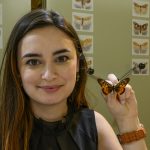 Graduated Fall 2020
Graduated Fall 2020
Email: apsdecarvalho@gmail.com
Website
ResearchGate
I am interested in butterfly sexual dynamics, especially on how male strategies to prevent female re-mating, like mating plugs, can be a result of sexual conflict. I want to analyze the relationship between the morphology of these strategies and the butterfly phylogenetic history in order to understand how these traits evolved. I also want to investigate what factors (ecological, biological, environmental, behavioral) are related to the presence of the mating plugs, why some closely related species diverge on the presence and absence of such structures and how the strategies affect male and female reproductive success.
Chandra Earl, Ph.D.
 Graduated Summer 2020
Graduated Summer 2020
Email: sunray1@ufl.edu
Harlan Gough, Ph.D.
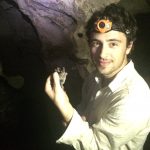 Graduated Summer 2020
Graduated Summer 2020
Email: goughh@ufl.edu
Chris Johns, Ph.D.
 Graduated Fall 2017
Graduated Fall 2017
Twitter
Instagram
Lary Reeves, Ph.D.
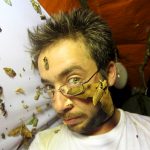 Graduated Fall 2017
Graduated Fall 2017
Email: laryreeves@gmail.com
Instagram
Twitter
I have broad interest across a variety of fields including entomology, herpetology, community ecology and biodiversity conservation, that converge on my current research project: the development of molecular methods for identifying faunal communities and detecting the presence of species. All animals, through the actions of blood and tissue feeding invertebrates, the shedding of hair and skin cells, saliva, waste products, decomposition, etc. – deposit DNA into their environment. For a period of time, this DNA persists and can be sampled, ultimately leading to the identification of the species from which the DNA was derived. These methods can be used to rapidly profile entire vertebrate communities, as well as determine the presence of target species – like the Burmese python in the Everglades.